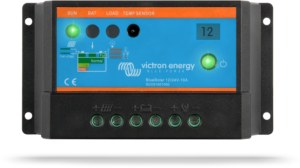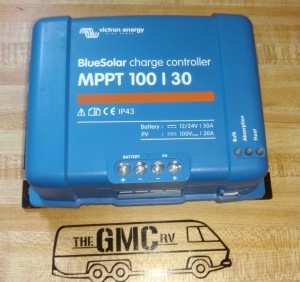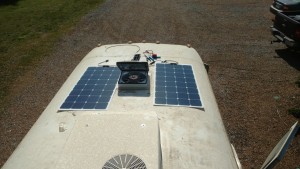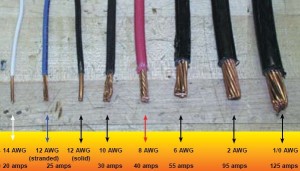This is a follow up to the last article on RV electrical Basics. (HERE)
Solar is relatively new to the RV world, or rephrase, AFFORDABLE solar is relatively new to the RV world. Gone are the days where it costs 1500 bucks to get a decent couple of hundred watts into your batteries. This new age of technology really does have benefits for our 40 yr old beasts!
The beauty of solar power is that it’s free. And it’s everywhere. You don’t have to be plugged in to get it, so you don’t have to be in an RV park listening to everyone else’s generators and TV’s and music and kids. You can set up away from everyone else and enjoy your trip. Did I mention it’s free?
Okay so maybe it’s not free per se, you so have to by some equipment to make it work, but once that initial money is spent it really is free. A decent solar system should last 15 or so years in daily use, on an RV it’s almost indefinite since we don’t leave them in in the sun and the weather 24/7/365.
So how does it work?
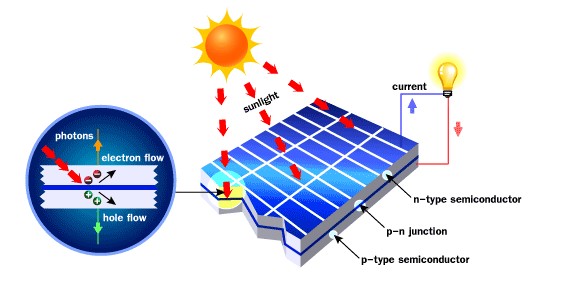
Solar power has been around for a good while (since 1954 in use), and the tech is constantly evolving for better efficiency and life. To simplify it to it’s core it goes like this:
The sun emits light (photons) which travel a long long way to get here, they hit the Photo Voltaic Cells in your solar panel and knock an electron loose, this electron then flows through your wires generating electricity. It’s obviously way more complicated than that, but if you want to know more there’s plenty of info out there. That’s the gist.
Getting those electrons is easy, you hook wires to the solar panel and boom, free electrons. The complication comes in doing something useful with those electrons.
Charge Controller
To harness those electrons that are just pouring out of your solar panels you’ll need a charge controller. A charge controller is (yet another) battery charger. The charge controller regulates current and voltage from the solar panels to charge your batteries.
There are 2 main types of charge controller for RV applications they are PWM (Pulse Width Modulation) and MPPT (Maximum Power Point Tracking).
PWM chargers are the simplest and cheapest. What they do is take the current from the solar panel and turn it on and off at a high rate to control how much charge your batteries get. The more “on” pulses you get the more power you put into the batteries. These range in price from $15-150 bucks depending on manufacturer. These are simple and work well. They are “smart” battery chargers (like the converters we talked about last time with the little man inside) so they know when to turn on and off to keep your battery at max capacity.
MPPT chargers are a bit more complicated. They track at what point your panels put out the most power and allow them to operate at that voltage(~17 volts for most 12V panels). The MPPT then converts this voltage with a DC-DC converter to the correct charge voltage for your battery. By doing this it’s able to keep the panels working to max efficiency all the time, no matter the conditions, where the PWM controller is just flicking a switch, the MPPT is actually working to get you the most bang for your buck. These range from 75-1000 depending on manufacturer and amp rating. I went with a Victron 100/30 MPPT controller personally.
Whichever way you go, we recommend getting a battery monitor or a controller with a remote readout so you can actually monitor your panels output and learn to use them effectively.
Panels
Panel prices have dropped considerably lately. You can get 100 watt panel for 140 bucks at Home Depot of all places. They are everywhere, do your research and find one with the wattage you want at the price point you want and pull the trigger. Grape solar and Renogy are both high quality brands at decent prices. We went with flexible panels from HQ Solar, but I won’t recommend them because they have some bad reviews, we’re happy with them so far, but longevity wise I am not sure. I decided to take the gamble, but wouldn’t recommend anyone else do the same without extensive research. (note these are our panels in testing, they are not yet mounted!)
Wiring
Wiring is a hot topic in the solar world. You can wire panels a variety of different ways. We’re currently experimenting with both parallel and series wiring of our panels, so I will update this when we have more definitive information.
As with all DC Wiring wire size is key. The bigger the better. You’ll see people stringing solar wires all over their roofs with 10awg or 12awg wires and then running 50 more feet of 12 awg to the controller and some 10 awg to the batteries. Will this charge your batteries? Sure. But will it charge them to the full potential of your solar system? No. I’ve read accounts of people getting 40% more charge current just by going larger on their wire size.
As always go big or go home on the wiring. We ran 6awg welding wire to our panels and 4awg from the batteries to the controller. We won’t use all this capacity, but If we need to add more panels later we have that ability without rewiring. We also don’t have to worry about the voltage drop along the wire runs losing power. Wire is pretty cheap, spend the extra 20 bucks on good wire, in the long run you’ll be happy you did.
So do I need it?
If you’ve gotten along just fine for the last 20 years without solar chances are no, you don’t NEED it. To me it’s more a convenience than a necessity. I plan to boondock a lot, so having extra power is always welcome. If your always driving or hooked up to power I see no need to make the investment. But otherwise there’s a few major advantages.
You can leave 12V on in your coach year round. You can keep your batteries topped year round. The smart controllers will keep your battery at float voltage just like a trickle charger only without having to plug anything in. This extends your battery life.
If you have a low draw system like we do (all led, few 12V loads) the solar can really extend your play time. If we average just 6 amps of solar (~100 watts average) over 8 hours of the day that’s 48 amp hours per day of extra capacity. If we leave all our lights on for that 8 hr period we only use 14.56 AH. Add all day of the stereo running and we’re still under 50 AH. So at the end of the day even if we’re just wasting electricity, we should still have a fully charged battery for night time endeavors.
Personally I think it’s a no brainer. For a couple hundred dollars you can have a simple 100watt system (a 100watt panel fits well on top of the roof pod if you’ve still got one), wiring will take half of an afternoon, and you will have that extra little bit of power that might just make your day (or night).


